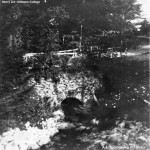Ford Glen Brook’s past         By: Claudia Corona          11/20/09
I walked to Ford Glen Brook and I looked at it. I looked at the little brook that had less water now because the weather in the past few weeks had not been fruitful enough to provide much rain; and I saw something else.
I saw a little brook that had captured my heart enough for me to want to know as much as I could about it. I remember researching its name earlier and learning that my little brook was named after someone. It was named âFord Brookâ, in memory of âgold old deacon Zadock Ford, the edge of whose farm was washed by itâ (Origins in Williamstown, p.15). Farther into the forest, âthe deepest and darkest stretch of glen through which the brook bickers along is called âFordâs Glenââ (Origins in Williamstown, p.15). Zadock Ford owned land by the brook in 1796, but no other record Iâve seen shows land by Ford Glen Brook being bought until 1882.
In 1882, Alfred C. Moon bought 100 acres in what would later be known as Hopkins Forest, and within these acres was some, if not all of the land surrounding Ford Glen Brook. In 1906, Alfred C. Moon sold 40 acres to Amos Lawrence Hopkins, and in them was land by Ford Glen Brook. âBy 1910, Buxton Farms (Hopkinsâ land) encompassed 1,636 acres and ran from Northwest Hill to the New York state border in the West, and Vermont in the North, excluding only the Moon Lotâ (Farms to Forest, p.10)…but including Ford Glen Brook. In 1912, Mr. Hopkins passed away. Alfred Moon lived on the remaining 60 acres that he had not sold to Hopkins until he died of a heart attack in 1924, the same year that Mrs.Hopkins stopped operation of the Buxton farms. A decade later in 1934, Mrs. Hopkins deeded the land to Williams College, who in turn, ârented itâ to the U.S. Forest Service in 1935 for $1, with the condition that when the forest service was done using the forest for experimental research, they would give the land back to the college. The U.S. Forest Service used the land until 1968, and then they gave it back to Williams College, who has owned Hopkins forest since then.
As I looked at the brook, I remember thinking that this was the end of Ford Glen Brook interaction with humans, but then I found out that this little brook had captured more hearts. In 1905, a year before Moon sold 40 acres to Hopkins, the Williamstown Boyâs Club was founded after a judge suggested that something be done about the fact that there were many young boys without any recreational facilities to go to or use. Following A.L. Hopkins death in 1912, The Boy’s Club camp started on part of the land owned by Hopkins sometime after his death but before Mrs. Maria Hopkins, gave it to Williams College. Even though Williams College deeded the land to the U.S. Forest Service in 1935, the Boyâs Club camp, located on Northwest Hill (by Ford Glen Brook) continued using the property as a day camp, but it closed down in the 1970s because of insurance concerns that the camp had.
Another thing that I learned but hadnât really thought about was that Ford Glen brook wasnât created with a bridge on it. The second picture is what the brook probably looked like before it had been dammed. Ford Glen Brook wasnât free for long, it was dammed in the late 1800s or early 1900s, Iâm sorry to say that Iâm not quite sure when. The first picture is another one of Ford Glen Brook, taken by Henry Art, professor at Williams College, showing the âdamâ, which also served as a bridge, made to allow people and vehicles across the brook without hassle. This bridge didnât last for long. In 1988, the bridge was reconstructed and made into a more stable and sturdy bridge, able to sustain heavier loads such as trailers and trucks.
In the end, Ford Glen Brook was not the same today. But it hadnât been the same yesterday, or last week, or last year, or 200 years ago! Being a small brook, I never really thought that Ford Glen had much of a history, until I remembered that everything has a history, and each day that goes by makes that history a deeper one, shaped by people, climate, and time.
SOURCES:
1st Photo: Unknown, was given to by Mike Miller
2nd Photo: Professor Henry Art of Williams College
Books:
Perry, L. Arthur., Origins in Williamstown., Arthur Perry, Williams College, MA, 1894.
The Williams Naturalists. Farms to Forests: A Naturalistâs Guide. Center for Environmental Studies, Williams College, MA, 1995.

